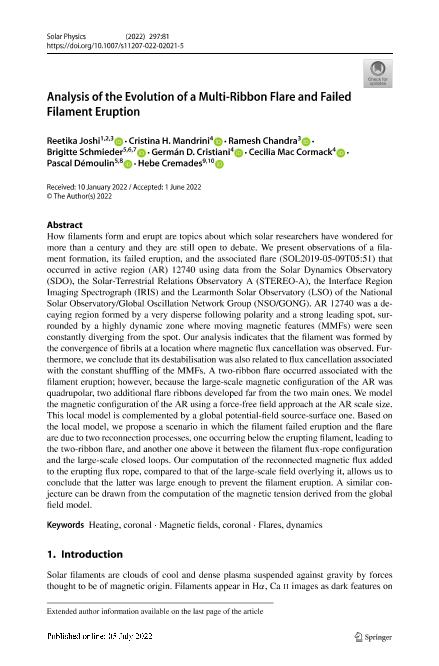Mostrar el registro sencillo del ítem
dc.contributor.author
Joshi, Reetika
dc.contributor.author
Mandrini, Cristina Hemilse

dc.contributor.author
Chandra, Ramesh
dc.contributor.author
Schmieder, Brigitte
dc.contributor.author
Cristiani, Germán Diego

dc.contributor.author
Mac Cormack, Cecilia

dc.contributor.author
Démoulin, Pascal

dc.contributor.author
Cremades Fernandez, Maria Hebe

dc.date.available
2023-05-17T17:08:46Z
dc.date.issued
2022-06
dc.identifier.citation
Joshi, Reetika; Mandrini, Cristina Hemilse; Chandra, Ramesh; Schmieder, Brigitte; Cristiani, Germán Diego; et al.; Analysis of the Evolution of a Multi-Ribbon Flare and Failed Filament Eruption; Springer; Solar Physics; 297; 7; 6-2022; 1-29
dc.identifier.issn
0038-0938
dc.identifier.uri
http://hdl.handle.net/11336/197816
dc.description.abstract
How filaments form and erupt are topics about which solar researchers have wondered for more than a century and they are still open to debate. We present observations of a filament formation, its failed eruption, and the associated flare (SOL2019-05-09T05:51) that occurred in active region (AR) 12740 using data from the Solar Dynamics Observatory (SDO), the Solar-Terrestrial Relations Observatory A (STEREO-A), the Interface Region Imaging Spectrograph (IRIS) and the Learmonth Solar Observatory (LSO) of the National Solar Observatory/Global Oscillation Network Group (NSO/GONG). AR 12740 was a decaying region formed by a very disperse following polarity and a strong leading spot, surrounded by a highly dynamic zone where moving magnetic features (MMFs) were seen constantly diverging from the spot. Our analysis indicates that the filament was formed by the convergence of fibrils at a location where magnetic flux cancellation was observed. Furthermore, we conclude that its destabilisation was also related to flux cancellation associated with the constant shuffling of the MMFs. A two-ribbon flare occurred associated with the filament eruption; however, because the large-scale magnetic configuration of the AR was quadrupolar, two additional flare ribbons developed far from the two main ones. We model the magnetic configuration of the AR using a force-free field approach at the AR scale size. This local model is complemented by a global potential-field source-surface one. Based on the local model, we propose a scenario in which the filament failed eruption and the flare are due to two reconnection processes, one occurring below the erupting filament, leading to the two-ribbon flare, and another one above it between the filament flux-rope configuration and the large-scale closed loops. Our computation of the reconnected magnetic flux added to the erupting flux rope, compared to that of the large-scale field overlying it, allows us to conclude that the latter was large enough to prevent the filament eruption. A similar conjecture can be drawn from the computation of the magnetic tension derived from the global field model.
dc.format
application/pdf
dc.language.iso
eng
dc.publisher
Springer

dc.rights
info:eu-repo/semantics/openAccess
dc.rights.uri
https://creativecommons.org/licenses/by/2.5/ar/
dc.subject
FLARES, DYNAMICS
dc.subject
HEATING, CORONAL
dc.subject
MAGNETIC FIELDS, CORONAL
dc.subject.classification
Astronomía

dc.subject.classification
Ciencias Físicas

dc.subject.classification
CIENCIAS NATURALES Y EXACTAS

dc.title
Analysis of the Evolution of a Multi-Ribbon Flare and Failed Filament Eruption
dc.type
info:eu-repo/semantics/article
dc.type
info:ar-repo/semantics/artículo
dc.type
info:eu-repo/semantics/publishedVersion
dc.date.updated
2023-05-17T15:21:51Z
dc.journal.volume
297
dc.journal.number
7
dc.journal.pagination
1-29
dc.journal.pais
Alemania

dc.journal.ciudad
Berlin
dc.description.fil
Fil: Joshi, Reetika. University of Oslo; Noruega
dc.description.fil
Fil: Mandrini, Cristina Hemilse. Consejo Nacional de Investigaciones Científicas y Técnicas. Oficina de Coordinación Administrativa Ciudad Universitaria. Instituto de Astronomía y Física del Espacio. - Universidad de Buenos Aires. Facultad de Ciencias Exactas y Naturales. Instituto de Astronomía y Física del Espacio; Argentina
dc.description.fil
Fil: Chandra, Ramesh. Kumaun University; India
dc.description.fil
Fil: Schmieder, Brigitte. Katholikie Universiteit Leuven; Bélgica. University of Glasgow; Reino Unido
dc.description.fil
Fil: Cristiani, Germán Diego. Consejo Nacional de Investigaciones Científicas y Técnicas. Oficina de Coordinación Administrativa Ciudad Universitaria. Instituto de Astronomía y Física del Espacio. - Universidad de Buenos Aires. Facultad de Ciencias Exactas y Naturales. Instituto de Astronomía y Física del Espacio; Argentina
dc.description.fil
Fil: Mac Cormack, Cecilia. Consejo Nacional de Investigaciones Científicas y Técnicas. Oficina de Coordinación Administrativa Ciudad Universitaria. Instituto de Astronomía y Física del Espacio. - Universidad de Buenos Aires. Facultad de Ciencias Exactas y Naturales. Instituto de Astronomía y Física del Espacio; Argentina
dc.description.fil
Fil: Démoulin, Pascal. Centre National de la Recherche Scientifique; Francia
dc.description.fil
Fil: Cremades Fernandez, Maria Hebe. Universidad de Mendoza. Facultad de Ingenieria; Argentina. Consejo Nacional de Investigaciones Científicas y Técnicas. Centro Científico Tecnológico Conicet - Mendoza; Argentina
dc.journal.title
Solar Physics

dc.relation.alternativeid
info:eu-repo/semantics/altIdentifier/doi/http://dx.doi.org/10.1007/s11207-022-02021-5
Archivos asociados
